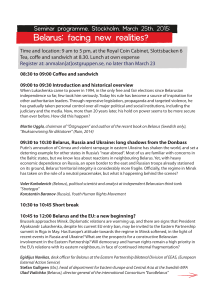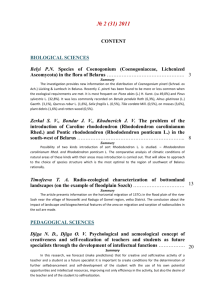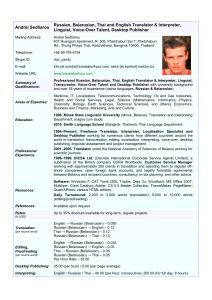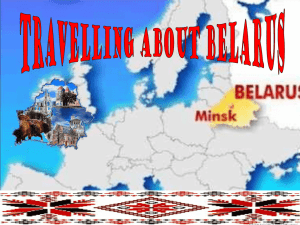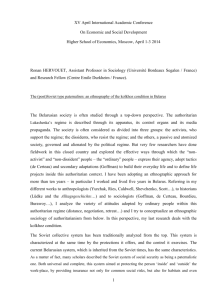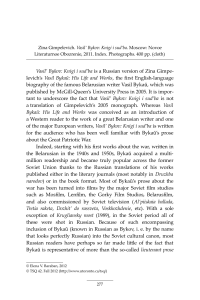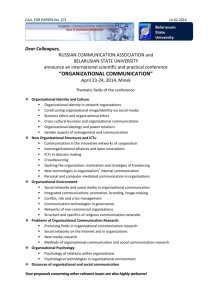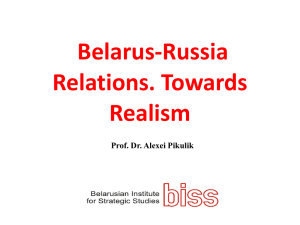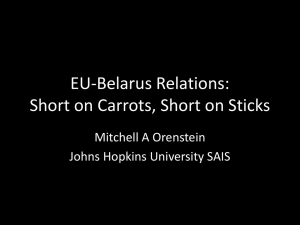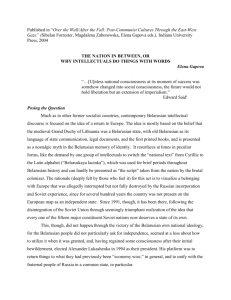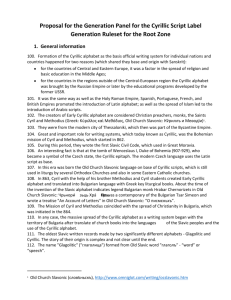review_Dounar - University of St Andrews
advertisement
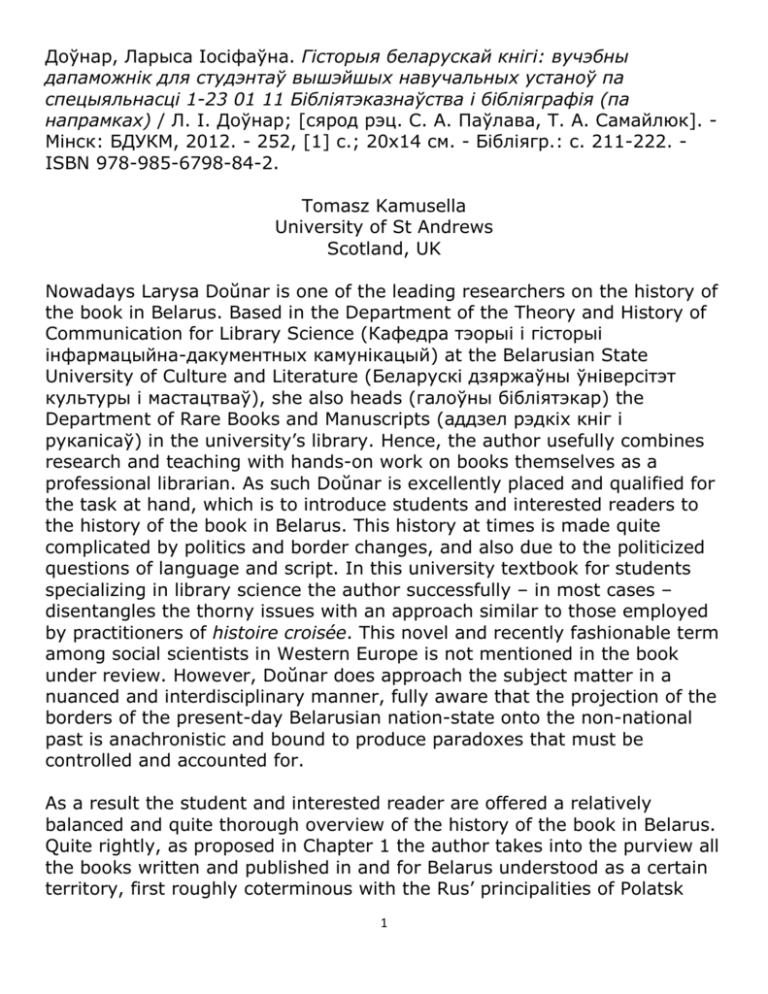
Доўнар, Ларыса Іосіфаўна. Гісторыя беларускай кнігі: вучэбны дапаможнік для студэнтаў вышэйшых навучальных устаноў па спецыяльнасці 1-23 01 11 Бібліятэказнаўства і бібліяграфія (па напрамках) / Л. І. Доўнар; [сярод рэц. С. А. Паўлава, Т. А. Самайлюк]. Мінск: БДУКМ, 2012. - 252, [1] с.; 20х14 см. - Бібліягр.: с. 211-222. ISBN 978-985-6798-84-2. Tomasz Kamusella University of St Andrews Scotland, UK Nowadays Larysa Doŭnar is one of the leading researchers on the history of the book in Belarus. Based in the Department of the Theory and History of Communication for Library Science (Кафедра тэорыі і гісторыі інфармацыйна-дакументных камунікацый) at the Belarusian State University of Culture and Literature (Беларускі дзяржаўны ўніверсітэт культуры і мастацтваў), she also heads (галоўны бібліятэкар) the Department of Rare Books and Manuscripts (аддзел рэдкіх кніг і рукапісаў) in the university’s library. Hence, the author usefully combines research and teaching with hands-on work on books themselves as a professional librarian. As such Doŭnar is excellently placed and qualified for the task at hand, which is to introduce students and interested readers to the history of the book in Belarus. This history at times is made quite complicated by politics and border changes, and also due to the politicized questions of language and script. In this university textbook for students specializing in library science the author successfully – in most cases – disentangles the thorny issues with an approach similar to those employed by practitioners of histoire croisée. This novel and recently fashionable term among social scientists in Western Europe is not mentioned in the book under review. However, Doŭnar does approach the subject matter in a nuanced and interdisciplinary manner, fully aware that the projection of the borders of the present-day Belarusian nation-state onto the non-national past is anachronistic and bound to produce paradoxes that must be controlled and accounted for. As a result the student and interested reader are offered a relatively balanced and quite thorough overview of the history of the book in Belarus. Quite rightly, as proposed in Chapter 1 the author takes into the purview all the books written and published in and for Belarus understood as a certain territory, first roughly coterminous with the Rus’ principalities of Polatsk 1 (Polotsk), Smolensk (Smalensk) and Turaŭ (Turov), and then with the post1569 Grand Duchy of Lithuania (less its ethnically Lithuanian northernmost section, nowadays overlapping with the national polity of Lithuania) in Poland-Lithuania until the late 18th century. In the early 19th century the area covered overlaps with Russia’s Wilno (Vilnius) School District, and after the 1830s with the northwestern Russian governorates (guberniias) of Grodno (Hrodna), Minsk (Mensk), Mogilev (Mahilioŭ), Smolensk (Smalensk), Vitebsk (Vitsebsk). Chapter 2 analyzes the hand written production of manuscripts in the aforementioned three Rus’ principalities between the 9th and 13th centuries. It is followed by Chapter 3 on manuscript culture in the entire period of Poland-Lithuania, or from the 13th through 18th centuries. Chapter 4 importantly focuses on the rise and development of the printed book in the Grand Duchy of Lithuania from the 16th through 18th centuries. Chapter 5 observes the slow and often stunted rise of Belarusian-language publishing during the Russian imperial times, set against the broader history of the book in the analyzed region. The Belarusian-language book is unambiguously connected to the rise of the ethnolinguistically defined Belarusian national movement. The official imperial policy of Russification, which meant a de facto ban on Belarusian-language publications between 1863 and 1906 (pp 96 and 105) is pointed to rather obliquely without mentioning the very term ‘Russification,’ or at least the imperial ideology of autocracy, Orthodoxy and nationality (peoplehood). Chapter 6 devoted to the Soviet period (1917-1989) is curiously constructed, perhaps reflecting the needs and guidelines of the official curriculum of national / state history as at present officially promulgated for use in the educational system across Belarus. First of all and most importantly, the quasi-colonial polity of the Land Ober Ost, established by the German occupation forces in the territory of the former Grand Duchy of Lithuania is not mentioned at all. However, Ober Ost existed from 1915 through 1918, and its educational and administrative policies were of paramount importance for unmaking the successes of Russification and for the rise of ethnolinguistic nationalisms of Belarusians, Jews, Latvians and Lithuanians. Apart from banning Russian and (to a degree) the employment of Cyrillic and replacing this language with German and Polish for official use, the occupation administration also, for the first-ever time in history, provided for the use of the Latin script-based Belarusian, Latvian, Lithuanian and Yiddish in local administration and schools. Hence, the rise 2 of the Belarusian-language school is indelibly connected to the Land Ober Ost. The policy of korenizatsiia (indigenization, nativization) in interwar Soviet Belarus built on this foundation, while the policy of Polonization gradually undermined these early achievements in the ethnically Belarusian lands incorporated into Poland after 1921. Last but not least, avoiding any analysis of the Land Ober Ost makes it impossible to explain why interwar Soviet Belarus, unlike other Soviet union republics (all officially monolingual), was officially quadrilingual (Belarusian, Polish, Russian and Yiddish) and triscriptural (Cyrillic, Hebrew and Latin scripts) between 1922 and 1938. The history of the Belarusian-language book in interwar Poland (not in the Soviet Union) is announced in section 2 of Chapter 6 under the anachronistic term ‘Western Belarus.’ The Treaty of Riga that concluded the Polish-Soviet War (1919-1921) (to which Soviet Ukraine was a party, too) features briefly at p 139, but this war is not mentioned, just one of its results, namely, the division of the ethnically Belarusian lands. Likewise, although the 1939 Soviet-German pact and the subsequent German attack on Poland are mentioned, the parallel Soviet onslaught on this country is passed over in silence, though one of its ramifications, that is, the unification of the ethnically Belarusian lands is briefly analyzed (p 151). In the respect of the aforementioned deficiencies, Chapter 6 is the weakest in the book, especially lacking a genuine analysis of the period 1915-1941 in relation to some crucial events that did define it. It creates a huge epistemological hurdle for students, who may be left scratching their heads when it comes to understanding what the sources were of and how the political and ethnolinguistic shape of present-day Belarus came about. Chapter 7 charters the history of the book in independent Belarus and the book is rewardingly concluded with Chapter 8 devoted to Belarusian emigration publishing from 1920 to this date. The author does not attempt to explain the phenomenon, but provides raw data clearly showing that between 1945 and 1985 the book production in Belarus was rapidly Russified, the share of Russian-language titles soaring from 12 per cent to 89 per cent during the period (pp 166-169). This tendency was briefly reverted in independent Belarus, the share of Russian-language titles dropping to 73 per cent in 1993. But the introduction of Russian as another official language in 1994 stopped this tendency, and the share of Russian3 languages titles began increasing again from 76 per cent in 1994 to 91 per cent in 2010 (pp 170-171, 198). Another issue to which Doŭnar devotes similarly oblique attention with no explication of the phenomenon is censorship in contemporary Belarus. This institution of authoritarian control over or even prevention of the freedom of speech and publication is mentioned by its name when this institution was officially phased out in the Russian Empire in 1905 (p 104). But there is no reflection on censorship (apart from Chapter 8 on emigrant publishing) either in Soviet or independent Belarus. But in Chapter 7, the author shows that in 1995 the Belarusian parliament passed a whole batch of acts, and in 2003 and 2010 the Belarusian President issued further decrees that aim at ‘controlling’ and ‘licensing’ (read: censoring) publishing in Belarus. (pp 179, 183, 193) I believe that the aforementioned silences and white spots in the author’s coverage of the 20th and 21st centuries are not reflective of her lack of knowledge on these topics, but rather of the ideological limits within which she is forced to write and do research. I wonder if the same may not be true of Doŭnar’s cursory treatment of Latin-, Polish- and Yiddish-language book publishing, while – quite surprisingly – the German occupation administration’s publishing in Reichskommissariat Ostland between 1941 and 1944 is given quite a lot of attention (pp 152-155). I wonder which ideological tenet might be responsible for that, especially in the context of the earlier silence on the Land Ober Ost. Although, as nowadays emphasized by the Belarusian national master narrative, the use of Arabic, Cyrillic, Hebrew and Latin scripts is lauded in the textbook, all the titles in other scripts than Cyrillic are given in Cyrillic transcription. The procedure is also extended to titles in Old (Church) Cyrillic, though in the majority of scholarly books published in today’s Russia and Ukraine these titles are given in the original script, IT technology allowing for an easy merger of Grazhdanka and Old Cyrillic fonts in a single text. The list of the mentioned Latin script-based Belarusian and Polish titles and their Cyrillic transcriptions is given in a table at pp 230-234 to allow students and readers to identify these publications. However, without any explanation, no similar tables of transcription for Old Cyrillic, Hebrew or Arabic script titles is provided. Then, some titles in Latin letters are left in the book untranscribed (pp 110, 122, 137, 141), which makes 4 me think that it was a late editorial decision to transcribe all Latin script titles and names into Cyrillic. It is most unfortunate, as apart from the rhetoric of national pride at Belarus’s four historic scripts (for instance, at the fourth page of the book’s cover, its title is given in five scripts and in eight languages: Ruthenian, Latin, Belarusian, Latin script-based Belarusian, Latin, Polish, Hebrew, Tatar, Yiddish and Russian), it as a must for students of library science to be able to read and operate in all the scripts in which books have been produced and collected in the country. The textbook would serve the students’ needs even better if it were supplied with indexes of book titles, personal names and place names. Given the high quality of paper and print in the volume, it should be possible to include color or greyscale illustrations of frontispieces of some interesting and significant books and periodicals. Maps would be of help, too. I am also surprised at the book’s bibliography that is limited to titles in Belarusian and Russian. I believe that excluding relevant items in English, German, Lithuanian, Polish or Yiddish seriously limits professional and research aspirations of students at whom this textbook is aimed. Last but not least, it is rather surprising if not altogether condescending to see that the acronym ‘M.’ stands in the bibliography for ‘Moscow’ as the place of publication, while the Belarusian capital of Mensk (Minsk) is spelled out in full. I realize it is an old Soviet practice that continues in today’s Russia. But in Belarus, of which Moscow is not a capital, it ought to be the other way round, with ‘M.’ for Mensk, or better less emotionally, all the places of publications should be spelled out, Moscow, as well. I learned a lot from the book. It helped me broaden and systematize my knowledge of Belarusian culture and publishing. Despite any lacunae observed in the work. After three decades of research on Central European history, it was easy enough for me to fill in the gaps. But I pity students, fresh from secondary school, who may be left at a loss in many places where some events are gratuitously glided over. January 3, 2015 5
